The ASUS ZenPad S (Z580CA) Review
by Brandon Chester on August 31, 2015 8:00 AM ESTSystem Performance
A common trend among the tablets I've reviewed in the past few months is that they've used Intel's mobile SoCs rather than the ARM SoCs that you'll see in most tablets and smartphones. All the tablets I've reviewed have come from manufacturers that traditionally made Windows PCs and laptops, and the long-term relationship they would have with Intel is a reasonable explanation as to why they've partnered with Intel for the processors in their tablets. Like both models of the Dell Venue 7000 series, and the top tier model of the ZenFone 2, the ZenPad Z580CA is powered by an Intel Atom Z3580 SoC. This is a quad core Atom part built on Intel's 22nm process, with a max burst frequency of 2.33GHz. In the case of the Z580CA it's paired with 4GB of LPDDR3-1600 memory, which is twice as much as the amount in the Dell Venue tablets.
To evaluate the ZenPad Z580CA's performance I've run it through our standard benchmark suite. The first set is our web benchmarks which is influenced both by a device's browser optimizations as well as its CPU, followed by BaseMark OS II to evaluate several aspects of a device's hardware, and finally PCMark which emulates tasks that a user would perform while actually using a device.
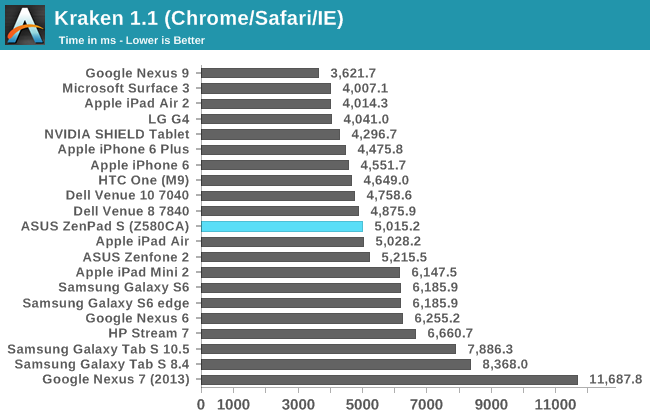
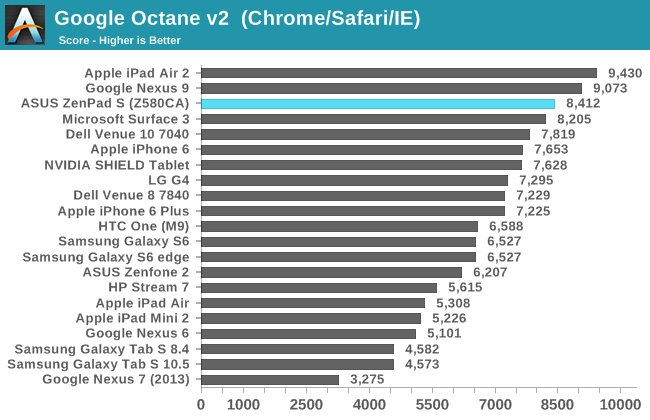

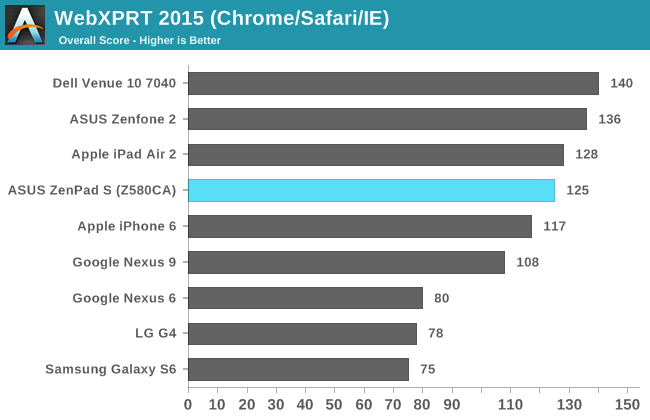
The ZenPad S performs well in our web browser benchmarks. There’s clearly differences at the OS level as well as possible BSP (board support package) differences between the ZenPad and other Intel-based Android devices like the Dell Venue tablets and the ZenFone 2. In Kraken we see a result closer to the middle of our chart, sitting among the Venue 8, Venue 10, ZenFone 2, and Apple’s A7-based iPads. It’s worth noting that as we no longer have those iPads for testing, the results for those devices were performed on iOS 7 and don’t benefit from any enhancements made to Apple’s rendering engine in subsequent releases.
In Google’s Octane benchmark the ZenPad S sits high on the chart with a score that isn’t quite as high as the Nexus 9 or the iPad Air 2, but sitting not far behind. There’s an enormous improvement over the ZenFone 2, and I’m not sure what to attribute this to as both devices use the same hardware platform and both are Android 5.0 underneath ZenUI. Since the test isn’t very long it’s not likely that it has to do with differences in thermal throttling between the two, and most likely is rooted somewhere in the software differences between the ZenFone and the ZenPad.
As for the 2013 and 2015 iterations of WebXPRT, the ZenPad S seems to perform much better in the latter test than it does in the former. While in WebXPRT 2013 it sits behind the iPhone 6 and the Nexus 9, in the 2015 iteration it surpasses both of them. In both cases it’s still behind the iPad Air 2, but for $299 you’re getting a lot of performance for your money.
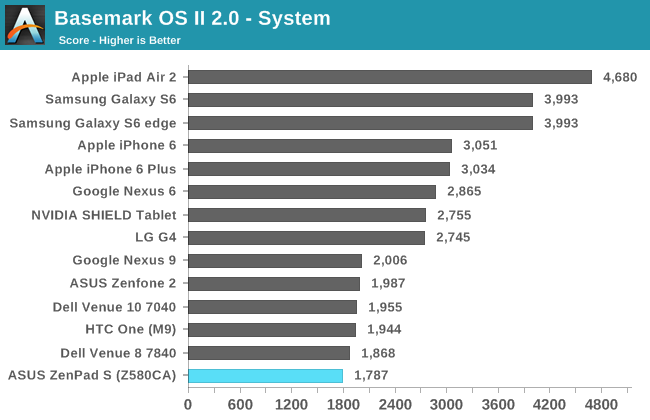
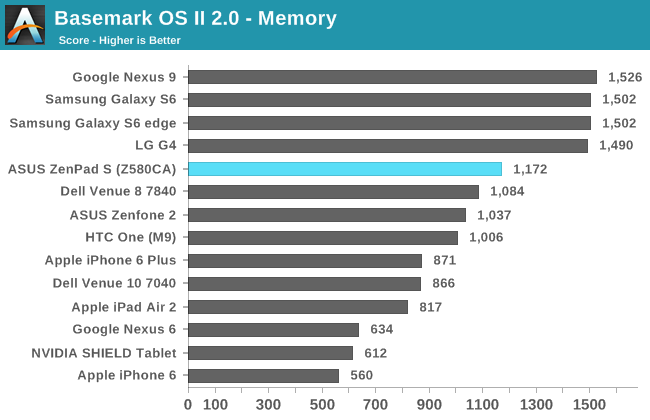
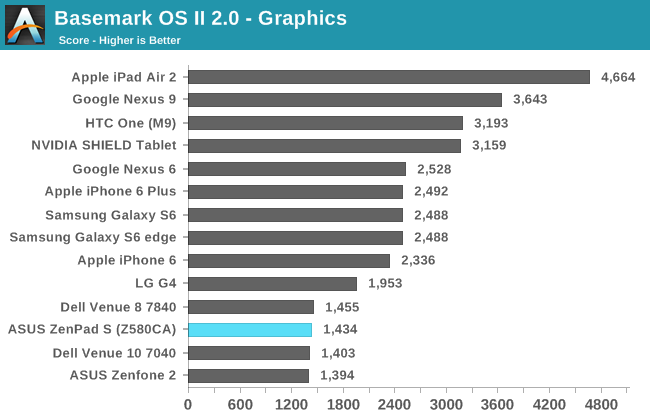

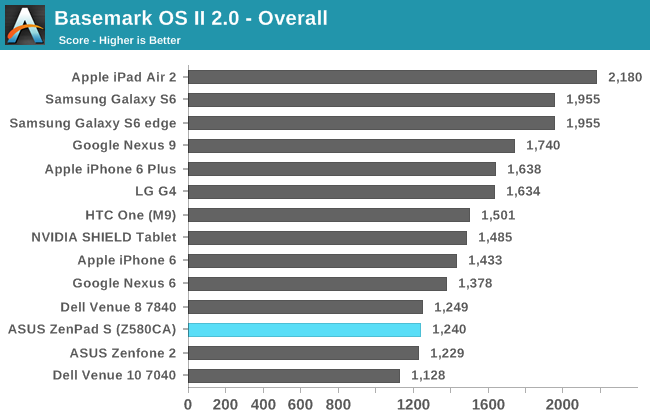
Like all the Intel-based Android devices that I’ve tested, the ZenPad S doesn’t score very high in BaseMark OS II. The score in the graphics sub-test is tied with all the other G6430 devices for last, which says more about how far GPU performance in mobile has come in two years rather than the ZenPad S simply being slow. The score in the system sub-test which stresses the CPU and RAM is the lowest on the chart. In the end all Intel Atom devices don’t perform well in BaseMark OS II, but when a device is $199 like the ZenFone 2 or $299 like the ZenPad S Z580CA I think the performance that the Atom SoC provides is more than sufficient.
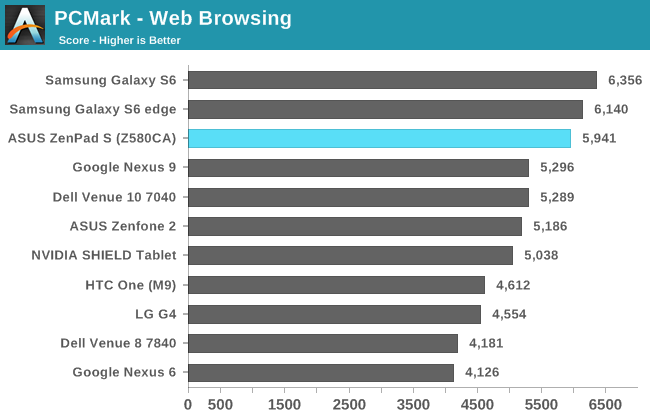
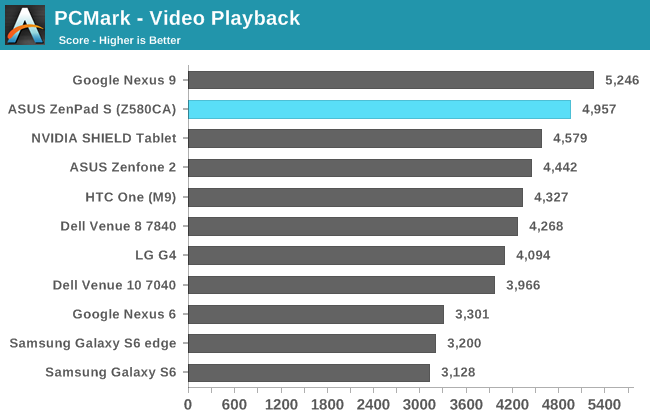

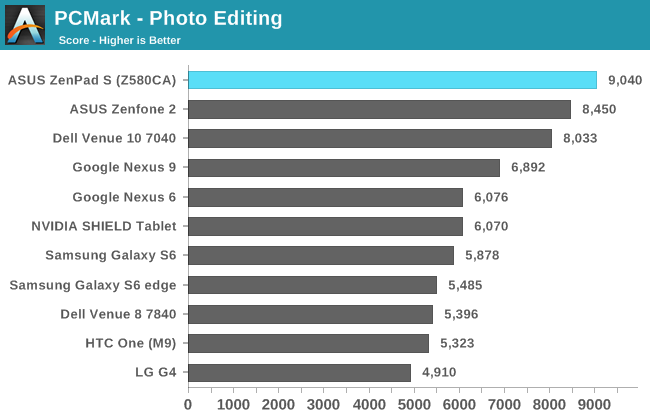

Our final test is PCMark, which emulates tasks that users will perform in the real world like browsing the web, playing and seeking videos, editing photos, and more. The ZenFone 2 performed very well in PCMark, but it ended up being carried to an extent by a disproportionately high photo editing score. The ZenPad S takes this even further with a higher photo editing score, and ends up taking the top spot in the overall ranking. There’s definitely a large software influence in these tests, which isn’t unlike the real world performance that is being tested, which requires both good hardware and optimized software to provide good performance. That being said, I think the ZenPad S ranking first on the basis of its extremely high photo editing score is a little bit questionable, but even without that test it would still score highly overall.
My conclusions about the system performance of the ZenPad S Z580CA are not unlike those in my ZenFone 2 review. When a device is $199 or $299, Intel’s Atom Z580CA SoC is faster than any ARM-based Android device at that price. PCMark doesn’t support iOS, and so there’s no way to know how well the ZenPad S compares to the iPad Mini 2 outside of web performance, but based on the JavaScript benchmark results it’s clear that the ZenPad S should be competitive with it, if not faster.










114 Comments
View All Comments
System Optimizer - Wednesday, November 4, 2015 - link
I contacted Asus to ask a few questions since I'm contemplating getting a ZenPad S (Z580CA).I asked if the wifi issue Brandon had reported, that he wrote in the article Asus said they were looking into, had been fixed. (I linked the article). The rep wrote back that they had no reports of any such issue. Don't know if that means they fixed it a while back and it can no longer be reproduced/no one is having the problem any longer, if the rep was clueless and the problem is still there and they didn't bother to read your article, or I wasn't taken seriously and the question wasn't passed down the line to the people in the know. Anyone with a Z580CA (or a C for that matter) able to confirm if the issue still exists?
I asked if the enhancement features Brandon mentioned as being annoyances (brightness adjustment, sharpness enhancement, etc) could be disabled, as I'd read a few other reviewers say they could (at least some of them). The rep replied back that they could all be disabled. Before I came home from work and saw that I had a message from the rep I had stopped by Best Buy and taken a look at the Z580C (not the CA) that they had on display, and I went exploring in the settings area. I can confirm that at least the CABC can be turned off in settings.
I asked if there were any plans for them to update the OS to Marshmallow at some point, or how long Asus (in general) tends to keep putting out patches and updates for their Android system (in other words what their company policy is). The rep said they contacted their Taiwan, and said they had no schedule for the next update. Don't know if that means they have an update in the works, and they have no idea when they are going to have it complete, or if it means they don't plan on working on or releasing any updates in the foreseeable future.
Sunburn74 - Thursday, November 26, 2015 - link
Just received a zenpad ca. Upgraded from a nexus 7 2013. Performance difference is night and day. You can install Google launcher to avoid the stupid zen launcher that comes with the tablet. This essentially makes the tablet feel like stock Android. Also whilst not all the bloat can be uninstalled it can all be disabled permanently. The performance really is very impressive. I received simultaneously a Google nexus 6p and the tablet seems to be smoother in performance overall despite the 6p having marshmallow. I think going with the Google stock launcher really makes this tablet much more pleasant to use. Also the side buttons are a little too firm for my taste and require you to use two hands to push the , one hand to hold the device stably and the other to actually push the button.jh20001 - Wednesday, December 2, 2015 - link
I was back in the market for shopping for a tablet as the one I just recently bought into (Lenovo) decided it needed a broken LCD by barely applying pressure to the screen (it was in my cargo pocket, screen facing my leg….and I leaned forward and it applied enough pressure to crack the glass and turn the LCD into all sorts of colors). So after TONS of research and reviews (ie, http://pocinc.net/blog/product-reviews/review-asus... ), I decided to give this one (ASUS) a chance. So far I love it. The screen looks nicer (they claim it is 2K resolution, but it doesn’t look much better than any other awesome tablet…it just simply looks awesome lol but not 4K like the TVs). It’s faster than my other one, has more space than it + has a card slot for more space and hasn’t given me any troubles yet.zero ozer - Tuesday, November 8, 2016 - link
I just bought my zenpad s last week.it was awesome but the only fall is the battery.3.5 to 4 hours in gaming,but I dont mind it for i am in my private practice.but what is odd is the 3 hours charging?why so long?I choose this because i think i was more practical than buying Samsung a with s pen.i wanted a tablet for gaming so I wont need a pen.I dont need a sim card.and choose this than ipad mini 2 cause the ipad mini 2 has may about just 2 more years before it will be outdated.I own iphone 4 thats why i have an idea about apple.with android you can just share it if your unit cannot download the latest apps.I think the unit can last upto 5 years or more with replacement of battery.it's a good tablet.it's just a little pricey for the battery issues.but in gaming and screen,awesome.